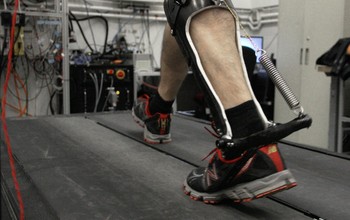Incredible Ankle Exoskeleton Device Makes Walking Easier, Better
| Ana Verayo | | Apr 06, 2015 10:08 AM EDT |
(Photo : College of Engineering, Carnegie Mellon University) Testing a passive-elastic ankle exoskeleton.
Engineers have revealed a breakthrough device that apparently makes walking faster and more efficient, not to mention easier.
This prototype exoskeleton boot covers just the knee to the ankle and using it saves up to seven percent energy during walking. This could lead to a new generation of wearable robotics that don't require a motor or even a power source to function.
Like Us on Facebook
This one pound device works by using a spring that stores energy and releases it during every step. An unpowered clutch engages a spring in parallel with the Achilles tendon when the foot is on the ground, offloading the calf muscles and making walking easier.
Unfortunately, the device is too bulky to wear under socks or even pants.
According to lead author Steven Collins from Carnegie Mellon University, the device doesn't really look bad and when you put them on for the first time, it feels a bit different. But after a few minutes, you won't notice them very much.
Collins also said recent studies show people bike less or even walk less if the activity seems hard. When walking becomes easier for them them, people can do it more and burn more calories, especially with these new types of devices.
This hydraulic cast won't only make walking easier and encourage physical activity for everyone. Its use isn't only limited to obese individuals but can also help the disabled walk better.
Exoskeleton devices not only for the legs but also for the hips can be innovated and developed as with the key clutch attached to the exoskeleton.
Collins admits he has no plans to manufacture this product commercially but encourages companies to do so. He says this has been more of an engineering feat where scientists can improve how humans walk without using any motors.
This study was published in the journal, Nature.
TagsEngineers Create Incredible Exoskeleton Device to Make Walking Easier, Better, exoskeleton boot walking, exoskeleton device walking engineers, how to walk easier
©2015 Chinatopix All rights reserved. Do not reproduce without permission
EDITOR'S PICKS
-

Did the Trump administration just announce plans for a trade war with ‘hostile’ China and Russia?
-

US Senate passes Taiwan travel bill slammed by China
-

As Yan Sihong’s family grieves, here are other Chinese students who went missing abroad. Some have never been found
-

Beijing blasts Western critics who ‘smear China’ with the term sharp power
-

China Envoy Seeks to Defuse Tensions With U.S. as a Trade War Brews
-

Singapore's Deputy PM Provides Bitcoin Vote of Confidence Amid China's Blanket Bans
-

China warns investors over risks in overseas virtual currency trading
-

Chinese government most trustworthy: survey
-

Kashima Antlers On Course For Back-To-Back Titles
MOST POPULAR
LATEST NEWS
Zhou Yongkang: China's Former Security Chief Sentenced to Life in Prison

China's former Chief of the Ministry of Public Security, Zhou Yongkang, has been given a life sentence after he was found guilty of abusing his office, bribery and deliberately ... Full Article
TRENDING STORY

China Pork Prices Expected to Stabilize As The Supplies Recover

Elephone P9000 Smartphone is now on Sale on Amazon India

There's a Big Chance Cliffhangers Won't Still Be Resolved When Grey's Anatomy Season 13 Returns

Supreme Court Ruled on Samsung vs Apple Dispute for Patent Infringement

Microsoft Surface Pro 5 Rumors and Release Date: What is the Latest?










